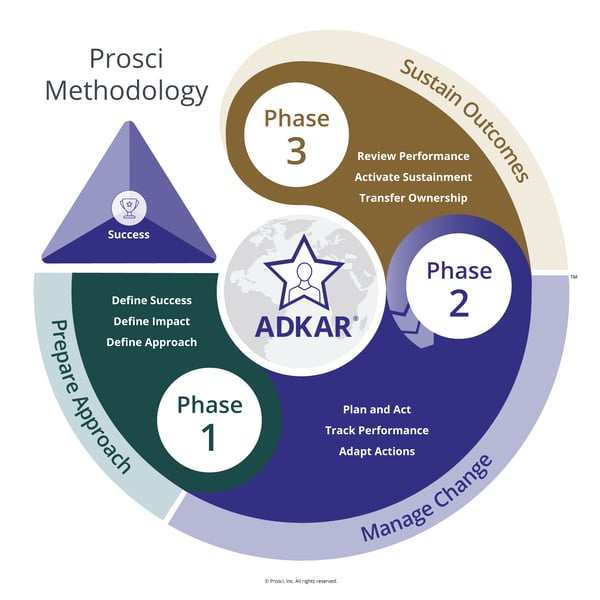
How Can HR Facilitate Change?
Read through these tips to see how HR teams can effectively facilitate change.
Encourage early involvement
Early involvement makes the entire change management process easier for HR and the rest of the organization because it enables access to the following information:
- What is the change?
- Why it’s necessary
- How it improves the business or organization
- How it affects different departments and their employees
With this information at the beginning of the process, HR teams can prepare effectively to manage people throughout the change. Giving HR a seat at the table at the beginning of any change management discussion creates the opportunity to get their feedback, involve them in the process, and allow them to implement measures for a smooth transition.
Create a change management network
Establishing a change network of HR professionals, team leaders from various departments, and C-suite executives is essential for planning and executing changes effectively. Consider team leaders from different departments to create an effective change management network. Everyone should understand the organization’s culture well and have a proven record of effective collaboration.
With this collaborative network in place, your business will be much better prepared to incorporate change. Plus, it gives you access to different viewpoints and areas of expertise to ensure any changes are suitable for the entire organization.
Have a HR change management plan in place
Once HR is present on a project—whether at the beginning, middle or end—they must know how to initiate and manage the people side of change. This is where creating an HR change management plan can help.
Here are some common steps you might want to include in an HR change management plan:
- Assess the upcoming change to understand what will happen and why it's necessary.
- Identify key stakeholders to know who's involved in the change, their role, and how to support them.
- Pinpoint potential challenges to prepare for hurdles and support team members through roadblocks.
- Outline desired outcomes to clearly define your goals and recognize when they're achieved.
- Create a Communications Plan to inform team members about the change, its timeline and its importance.
- Develop a Training Plan to ensure everyone is ready for the change.
- Implement a Sponsor Plan to engage top leaders in actively supporting and communicating the change.
- Establish a People Manager Plan to involve managers in guiding their teams, acting as communicators, liaisons and coaches through the change process.
An effective HR change management plan keeps your team on track during shifts in the workplace. This way, your team can quickly adapt, keeping your business moving forward without missing a beat.
Use the Prosci Methodology
The Prosci Methodology is a framework for managing change. It helps organizations put people at the center of change, ensuring everyone can adopt and embrace changes in their work.
Here’s an overview of the three frameworks comprising the methodology:

Let’s look at each framework in more detail:
- Prosci Change Triangle (PCT) Model. A framework for establishing and connecting the most important aspects of any successful change effort, it highlights where change management fits into the bigger picture by breaking it down into four critical aspects of change—Success, Leadership/Sponsorship, Project Management and Change Management.
- Prosci ADKAR Model. ADKAR is an acronym for Awareness, Desire, Knowledge, Ability and Reinforcement. It’s a model for guiding individuals through the experiences needed to make change.
- Prosci 3-Phase Process. A structured yet flexible framework for driving change at an organizational level. It works through three phases—Phase 1 – Prepare Approach, Phase 2 – Manage Change, and Phase 3 – Sustain Outcomes—to successfully implement change.
When facilitating change, you can think of the Prosci Methodology as a detailed checklist for HR teams. They can work their way through the framework to provide the best support for individuals transitioning from a current state to a future one.
Get in touch with us for more information on these components or more support with your change management solutions.
Build commitment and support for change management
As mentioned, one of the key roles of HR within change management is to increase employee buy-in and commitment. In doing so, change becomes easier, more efficient, and more effective in the long term.
Here are two essentail ways HR teams should build support for change management:
Demonstrate clear benefits and WIIFM
The most effective way to get "a seat at the table" at the beginning of any project requires you to demonstrate the WIIFM (or "What’s in it for me?") to people. To do this, you need to articulate how change will benefit individuals and help them overcome the barriers to change that lead to resistance behaviors.
For example, help employees understand how it will improve their work lives, job security, career opportunities or job satisfaction.
Tailor any communication
Customize communication to address the specific concerns, needs and interests of different stakeholder groups. By reaching out about individual concerns, you’re helping teams understand more about the change and why it’s necessary, which in turn creates a supportive environment.
For example, if a project manager is concerned that new changes will hinder productivity, you can speak to this directly. Or, if sales teams are worried about the impact on leads, you can address this.
Provide organizational learning and development
Organizational learning and development can help businesses during change management, making them more resilient and adaptable. When goals are constantly shifting and intensifying—as they are in most enterprise companies—these skills are essential to success.

Here are some ways to incorporate learning and development to facilitate change:
Take change management training
Ensure you and all relevant people have the skills and understanding to manage change successfully. You can invest in training, like Prosci role-based training programs, to prepare and equip people managers, front-line employees, and sponsors to fulfill their specific roles.
"Our plant has been working on managing a 'cultural change’ project. We have invested thousands of hours planning and developing the strategy. If we had the opportunity to attend Prosci ‘change management training’ and to use the tools provided in it before starting this project we could have cut the amount of time and money spent by at least 50%."
—Jose Gonzales, LEAR, Director of Human Resources
Identify learning needs
Conduct a needs assessment to understand skill gaps in your workforce and provide the necessary training to close those gaps. This can involve launching online surveys, conducting performance evaluations, or gathering employee feedback to spot where skills are lacking.
Incorporate mentoring, coaching, and peer-to-peer learning
Encourage the sharing of knowledge and skills among employees through peer-to-peer learning, communities of practice, and knowledge-sharing platforms.
For example, you could start by pairing experienced employees with those seeking to enhance their skills. This fosters a culture of continuous learning and builds relationships between employees which can improve collaboration during change management.
To apply these tips, consider these next steps:
- Identify specific training – Equip your team with change management tools, knowledge and skills with targeted training like Prosci role-based training programs or eLearning courses.
- Gauge needed skills – Use assessments to discover where your team can improve and grow.
- Create a system for knowledge exchange – Create opportunities where team members can learn from one another’s experiences on a regular cadence, such as building them into existing meetings.
Get Ready for Change With Prosci
HR professionals play a crucial role in change management. By supporting people throughout the process, addressing their concerns, and providing transparency, they help ensure everyone understands the reasons behind the change and how to succeed through changes. And your organization benefits from more commitment and alignment across teams, higher morale, and improved results from change initatives.

.png?width=500&height=163&name=7X%20more%20likely%20circles-2023%20(1).png)



